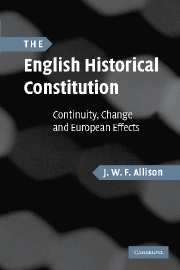Book contents
- Frontmatter
- Contents
- Table of Cases
- Preface
- 1 Introduction
- 2 A historical constitutional approach
- 3 The Crown: evolution through institutional change and conservation
- 4 The separation of powers as a customary practice
- 5 Parliamentary sovereignty and the European Community: the economy of the common law
- 6 The brief rule of a controlling common law
- 7 Dicey's progressive and reactionary rule of law
- 8 Beyond Dicey
- Conclusions and implications
- Bibliography
- Index
4 - The separation of powers as a customary practice
Published online by Cambridge University Press: 18 December 2009
- Frontmatter
- Contents
- Table of Cases
- Preface
- 1 Introduction
- 2 A historical constitutional approach
- 3 The Crown: evolution through institutional change and conservation
- 4 The separation of powers as a customary practice
- 5 Parliamentary sovereignty and the European Community: the economy of the common law
- 6 The brief rule of a controlling common law
- 7 Dicey's progressive and reactionary rule of law
- 8 Beyond Dicey
- Conclusions and implications
- Bibliography
- Index
Summary
In Chapter Three, I suggested that the Crown, however confused from an analytical perspective, proved capacious and accommodated the reality of representative institutions as they evolved in the English historical constitution. The Crown's singularity and the unity it symbolised did not preclude the development of various democratic institutions and powers and even talk of their separation on both sides of the Channel. In this chapter, I will elaborate on the doctrine of the separation of powers to illustrate both further interactions between the English common law and Continental European law and the peculiar significance of the English historical constitution's customary mode of formation or development.
Historians have had reason to describe a unity in European constitutional development absent from the history of European private law. For example, in An Historical Introduction to Western Constitutional Law, Raoul van Caenegem emphasises the lack of a difference between constitutional evolution in England and that on the Continent comparable to the difference he describes in his earlier work on the history of private law:
The English constitutional evolution was not essentially distinct from that of the Continent. There were differences in timing and accent, but the main ingredients such as monarchy, feudalism, absolutism, parliaments, constitutions, bureaucratization and the welfare state were common. The absence from the English common law of the Corpus Iuris Civilis, which was so vital a factor in the private field, was unimportant for constitutional development.
- Type
- Chapter
- Information
- The English Historical ConstitutionContinuity, Change and European Effects, pp. 74 - 102Publisher: Cambridge University PressPrint publication year: 2007



